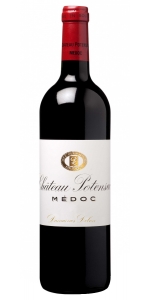Wine from Potensac

The estate has been in the same family since time immemorial and has always been handed down by women. The current owner, Jean-Hubert Delon, inherited the estate from his paternal grandmother, Georgette Liquard. Although close to the river, Potensac is situated on a high point of land in North Medoc. Because of this position, the site has been populated since ancient times. The name "Medoc" in fact comes from "medio aquae" which means "in the middle of the waters"…
Planted on the best quality soils in the Ordonnac district, the vineyards now extend over 60 hectares on a terroir where the typical characteristics of each grape variety express themselves very distinctly and give the wine superb ageing potential.
The vineyards spread mainly over hilly mounds with a limestone subsoil covered with clay and gravel outcrops containing a high proportion of gravel ("graves"). These limestone soils are very similar to those found in the Saint-Estèphe appellation. On this very special terroir, some plots of Cabernet Sauvignon and Cabernet Franc planted over 80 years ago still produce perfectly ripe, healthy grapes. The hamlet of Potensac was already cited in the first edition of Féret for the special characteristics and longevity of its wines.
Potensac Medoc is made from 44% Merlot, 33% Cabernet Sauvignon, 22% Cabernet Franc and 1% Petit Verdot.
The estate's Grand Vin's vineyards are located west of the village of Ordonnac where the vines grow on gravelly-clay soiils. They produce a very fine wine with tight texture, richness and wonderful freshness. On the palate, the wine is pure and powerful, with great concentration, dense and spicy tannins, and mineral tension. Fresh and full-flavored with ripe black fruits, and a finish of great depth. Thanks to these qualities, Château Potensac is often considered to represent the "pure Medoc style". It should be noted that Potensac was the only "Cru Bourgeois Exceptionnel" of its appellation, and certainly one of the most persistent ever produced at this stage.
- back
Selected Options
Wineries
Categories
Pricing
Countries
Regions
Grape Types
Wineries
Organic/Free Shipping
All older vintage wines have been purchased from a single collectors cellar. Pictures can be requested before shipment.
Intense, fresh and fruity bouquet, reminiscent of a tangy red fruit tart (wild strawberry, blueberry), slightly sweet yet underpinned by more concentrated, jammy and citrus notes. The aromatic complexity comes through after a few swirls in the glass giving us a medley of spice, warm cinnamon and peppers. Fleshy attack dominated by ripe, crunchy, plump red fruit that brings depth and creaminess. The fruity structure is gradually elongated by a chalky, mineral freshness that creates a lingering sensation of lightness and harmony on the finish.
Review:
Roederer's 2014 Brut Vintage is beautiful, offering up aromas of pear, mirabelle plum, red berries, warm biscuits and smoke. Full-bodied, layered and elegantly muscular, it's seamless and complete, with terrific mid-palate depth and amplitude. Framed by bright acids and enlivened by a pinpoint mousse, it concludes with a penetrating finish. The blend is 70% Pinot Noir, emphasizing Verzy, and pressure is a touch higher than in its more ethereal Blanc de Blancs counterpart. As I wrote of its 2013 predecessor, this is a wine that puts many prestige cuvées to shame.
95 Points Robert Parker's Wine Advocate





